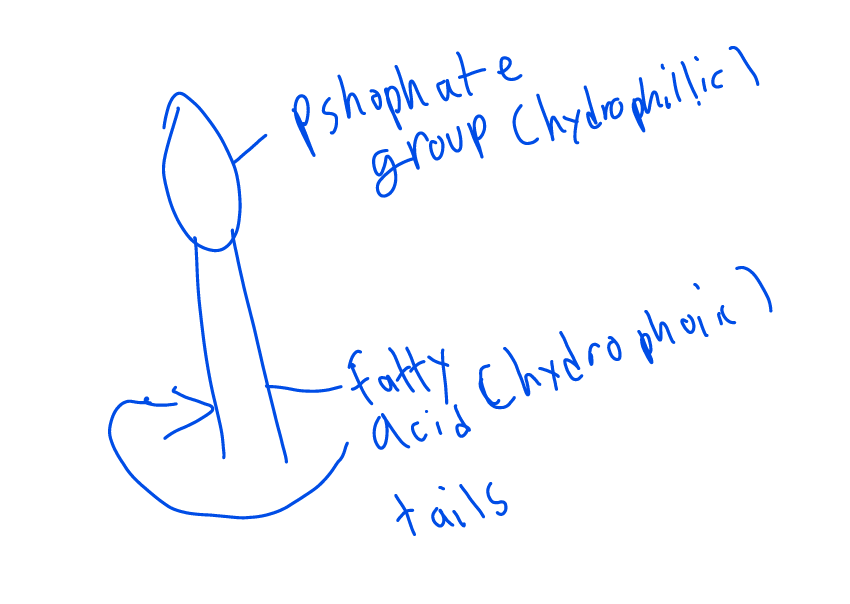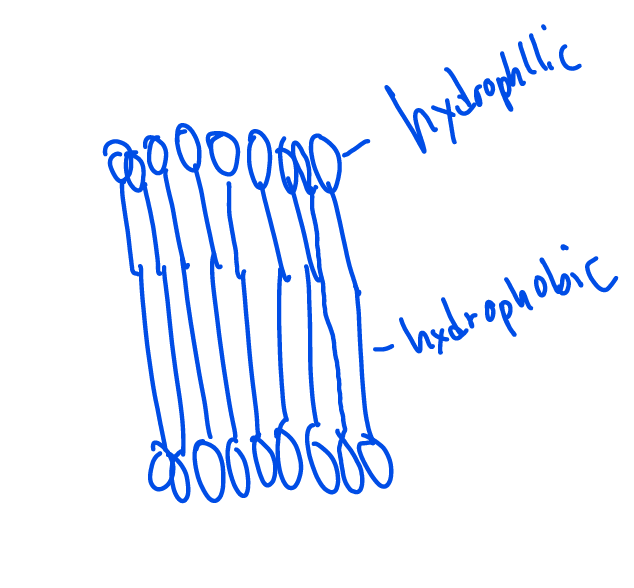Chapter 7 Bio 1406
1/47
There's no tags or description
Looks like no tags are added yet.
Name | Mastery | Learn | Test | Matching | Spaced |
|---|
No study sessions yet.
48 Terms
What does it mean that the plasma membrane is selectively permeable?
Only certain substances are allowed through the plasma membrane
How are plasma membrane selectively permeable?
Proteins are created to allow certain substances to travel through the hydrophobic component of the lipid bilayer
What are the most common lipids in plasma membrane?
Phosplipids
Basic structure of phospholipid (draw)

Phospholipid Bilayer (draw)

Phospholipids are amphipathic, this means that
they contain both hydrophobic and hydrophilic components
The fluid mosaic model:
fluid: explains movement in cell
Mosaic: Model that explains structure of cells
What membrane components can move across the bilayer & how?
Lipids, Proteins; Laterally (side-by-side)
Difference between saturated fatty acids and unsaturated fatty acids
Saturated (dense) fatty acid: no double bond between carbons/hydrogens in skeleton; therefore less movement/space
Unsaturated (non-dense) fatty acid: one carbon bond in carbon skeleton, resulting in “kink” tail; therefore more movement/space
As temperature cools, how does membrane fluidity change
More unsaturated fatty acids in phospholipid, to allow nutrients to come in
As temperature heats, how does membrane fluidity change
Due to excess nutrients in this temperature, phospholipid’s fatty acids become saturated to avoid excessive intake
How does cholesterol affect membrane fluidity?
Applies only to animal cell
Acts as a buffer for fluidity
At cold temps, it increases fluidity to prevent tight packing
At hotter temps, it decreases fluidity to prevent excessive intake
What determines most of a membranes specific functions?
Proteins
Peripheral Proteins
Proteins that are embedded in either the upper or lower phosphate head of the lipid bilayer
Integral Proteins
Proteins that are penetrate through the phosphate head and station themselves inside the hydrophobic tails of lipid bilayer
Transmembrane proteins
Integral proteins that penetrate lipid bilayer to the point they open and exit at the upper and lower phosphate heads
What are six functions of proteins in cell membranes.
1) Transportation of materials
2) Enzyme Activity
3) Receptor Proteins
4) Cell to Cell Identification
5) Joining with other cell membranes
6) Attach to extra cellular matrix and/or cytoskeleton
How do cell recognize each other?
By binding to carbohydrates on surface.
Glycoproteins are most common
Glycolipids are also possible
How do hydrophobic (non-polar) molecules move through lipid bilayer.
Dissolve in lipid bilayer and can move rapidly. E.g. oxygen or carbon dioxide
How do Hydrophilic (polar) molecules move through lipid bilayer.
Ions or polar molecules have a hard time moving through lipid bilayer
Diffusion
The tendency for any group of molecules to spread out evenly over time. Without energy
Passive Transport
Diffusion of substances through plasma membrane without any dedicated energy investment from cells
Equilibrium
As a result of diffusion, molecules are equally spread across both sides of membrane
Concentration Gradient
Solute’s moving from higher concentration to lower concentration
Osmosis
diffusion of water molecules, water will go from lower concertation to higher concentration in order for all substances to achieve equilibrium
Tonicity
The ability of a outside solute to cause a cell to gain/lose water
Hypertonic
The solute concentration OUTSIDE of the cell is higher than the solute concentration inside of the cell. Therefore, the water will leave to cell for the outside.
Hypotonic
The solute concentration OUTSIDE of the cell is higher than the solute concentration inside of the cell. Therefore, the water will leave to cell for the outside.
Isotonic
Solute concertation OUTSIDE of cell is same as inside cell. Therefore, there will be not water movement.
Lysed Meaning
(red cell) For hypotonic solution, water will rush inside cell. Caused the cell to rupture.
Shrivel/Crenation
(red cell) For hypertonic solution, water will try to exit blood cell, causing poles to form.
Osmoregulation
the maintenance of stable solute/water concentrations
Turgid
Hypotonic = Water In = Turgidity
Flaccid/Limp
Isotonic = equal water movement = flaccid
Plasmolysis
Hypertonic = Water Out = Shrinkage/Plasmolysis
Facilitated Diffusion
Transport proteins increase passive diffusion of molecules
Active Transport
Moving substances against their natural concentration gradient with the use of ATP
Active Transport Example
Substance A is unwanted in cell/ Substance B is wanted. A is attached to protein and ATP cell causes phosphate group to attach to protein. Protein shape changes and A is expelled. Substance B is inserted from outside, phosphate group detaches causing protein to restructure into original shape. Substance B is dumped inside cell.
Ion Pumps
Transport proteins that move certain ions AGAINT their concentration gradient with the use of energy (ATP)
Membrane Potential
difference in electrical charges of charged atoms inside membrane and outside membrane
Electrochemical gradient
Two forces that cause the diffusion of ions
The two forces in electrochemical gradient
As name implies:
Electrical: The charges of ions that cause attraction
Chemical: natural concentration gradient
Electrogenic Pump
transport protein that engages in active transport, uses ATP
e.g. sodium-potassium pump (animal) or proton pump (plant/fungi)
Cotransport
active transport indirectly causes another type of transport to happen in cell membrane
Bulk transport
Active transport of large solutes through vesicles (e.g. proteins/polysaccharides)
Exocytosis
Bulk Transport; transport vesicles leave cell membrane and dump contents outside
Endocytosis
Bulk Transport: outside foreign materials are converted by plasma membrane into vesicles that than enter cell
Endocytosis Three Examples
1) Phagocytosis: Food particle is converted into food vesicle by plasma membrane
2) Pinocytosis: Liquid particle is converted into transport vesicle by cell plasma membrane
3) Receptor-mediated endocytosis: the plasma membrane will use receptors to attract specific molecules (ligands) and create them into vesicles.